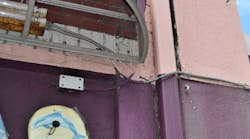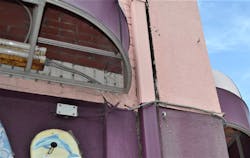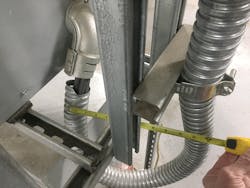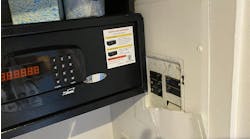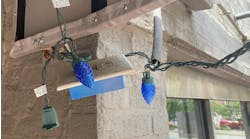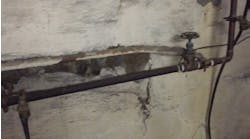All references are based on the 2017 edition of the NEC.
Wet Location Worries
A close look at the wiring under this exterior awning reveals MC cable was used as a wiring method for this outdoor wet location. Section 330.10(A)(11) does permit certain types of MC cable to be used in wet locations. For use in wet locations, the MC cable must have a corrosion-resistant jacket over the metal covering and meet any of the following conditions: A) The metallic cable covering must be impervious to moisture; B) A moisture-resistant jacket must be provided under the metal covering; C) The insulated conductors in the cable must be listed for wet location use. The commonly used interlocked metal tape-type of MC cable that was installed here does not meet all those requirements. MC cable with an overall nonmetallic covering is available and would be a better cable wiring method option here. Another concern is the amount of cable supports. Section 330.30(B) requires cables with four or less conductors of size 10 AWG or smaller to be secured within 12 in. of each cable termination. Another problem is some of the bends in the cables are very tight and appear to violate the bending radius requirements spelled out in Sec. 330.24. Making bends that are too tight can damage the cable jacket and the insulation on the conductors inside the cable.
Crazy Conduit Curves
The person who installed the flexible metal conduit (FMC) to this transformer apparently didn’t peek at the bending rules in Sec. 348.24. Bends in FMC can be made manually, without the use of any auxiliary equipment, but the radius of the curve to the centerline of any bends must not be less than described in the “other bends” column of Table 2 in Chapter 9. For this 2-in. FMC, Table 2 requires a minimum of 12 in. to the centerline of the conduit bend. The dimension for the bend in the photo comes up short by 6½ inches. In fact, this bend is so tight that the conduit has separated from the connector due to all the strain from such a sharp bend. This separation and lack of continuity creates even more violations and elevates the shock and fire hazard. Section 300.10 requires metal raceways to be metallically joined together to form a continuous electrical conductor. The raceway is also required to be mechanically secured and connected to any boxes, cabinets, and fittings to establish effective electrical continuity. Therein lies the problem. Sliding the transformer a little farther left from the edge of the strut could help solve the installers problems here.
